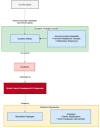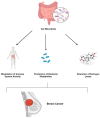Emerging Role of Gut Microbiota in Breast Cancer Development and Its Implications in Treatment
- PMID: 39728464
- PMCID: PMC11676198
- DOI: 10.3390/metabo14120683
Emerging Role of Gut Microbiota in Breast Cancer Development and Its Implications in Treatment
Abstract
Background: The human digestive system contains approximately 100 trillion bacteria. The gut microbiota is an emerging field of research that is associated with specific biological processes in many diseases, including cardiovascular disease, obesity, diabetes, brain disease, rheumatoid arthritis, and cancer. Emerging evidence indicates that the gut microbiota affects the response to anticancer therapies by modulating the host immune system. Recent studies have explained a high correlation between the gut microbiota and breast cancer: dysbiosis in breast cancer may regulate the systemic inflammatory response, hormone metabolism, immune response, and the tumor microenvironment. Some of the gut bacteria are related to estrogen metabolism, which may increase or decrease the risk of breast cancer by changing the number of hormones. Further, the gut microbiota has been seen to modulate the immune system in respect of its ability to protect against and treat cancers, with a specific focus on hormone receptor-positive breast cancer. Probiotics and other therapies claiming to control the gut microbiome by bacterial means might be useful in the prevention, or even in the treatment, of breast cancer. Conclusions: The present review underlines the various aspects of gut microbiota in breast cancer risk and its clinical application, warranting research on individualized microbiome-modulated therapeutic approaches to breast cancer treatment.
Keywords: breast cancer; cancer immunotherapy; dysbiosis; gut microbiota; hormone metabolism.
Conflict of interest statement
The authors declare no conflict of interest.
Figures






Similar articles
-
Role of Gut Microbiota in Breast Cancer and Drug Resistance.Pathogens. 2023 Mar 16;12(3):468. doi: 10.3390/pathogens12030468. Pathogens. 2023. PMID: 36986390 Free PMC article. Review.
-
Breast and Gut Microbiota Action Mechanisms in Breast Cancer Pathogenesis and Treatment.Cancers (Basel). 2020 Aug 31;12(9):2465. doi: 10.3390/cancers12092465. Cancers (Basel). 2020. PMID: 32878124 Free PMC article. Review.
-
The Roles of Inflammation, Nutrient Availability and the Commensal Microbiota in Enteric Pathogen Infection.Microbiol Spectr. 2015 Jun;3(3). doi: 10.1128/microbiolspec.MBP-0008-2014. Microbiol Spectr. 2015. PMID: 26185088
-
Gut and Breast Microbiota as Endocrine Regulators of Hormone Receptor-positive Breast Cancer Risk and Therapy Response.Endocrinology. 2022 Nov 14;164(1):bqac177. doi: 10.1210/endocr/bqac177. Endocrinology. 2022. PMID: 36282876 Free PMC article.
-
Connecting the immune system, systemic chronic inflammation and the gut microbiome: The role of sex.J Autoimmun. 2018 Aug;92:12-34. doi: 10.1016/j.jaut.2018.05.008. Epub 2018 Jun 1. J Autoimmun. 2018. PMID: 29861127 Review.
Cited by
-
Microbiota as diagnostic biomarkers: advancing early cancer detection and personalized therapeutic approaches through microbiome profiling.Front Immunol. 2025 May 8;16:1559480. doi: 10.3389/fimmu.2025.1559480. eCollection 2025. Front Immunol. 2025. PMID: 40406094 Free PMC article. Review.
-
Association between a dietary index for gut microbiota and breast cancer history in adult women: findings from NHANES 2011-2020.Front Nutr. 2025 Jun 17;12:1619809. doi: 10.3389/fnut.2025.1619809. eCollection 2025. Front Nutr. 2025. PMID: 40599546 Free PMC article.
-
Anticancer Potential of Prebiotics: Targeting Estrogen Receptors and PI3K/AKT/mTOR in Breast Cancer.Biomedicines. 2025 Apr 18;13(4):990. doi: 10.3390/biomedicines13040990. Biomedicines. 2025. PMID: 40299687 Free PMC article. Review.
-
Melatonin from Plants: Going Beyond Traditional Central Nervous System Targeting-A Comprehensive Review of Its Unusual Health Benefits.Biology (Basel). 2025 Jan 30;14(2):143. doi: 10.3390/biology14020143. Biology (Basel). 2025. PMID: 40001911 Free PMC article. Review.
References
Publication types
LinkOut - more resources
Full Text Sources

